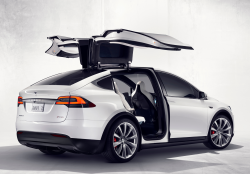
— A Tesla Model X "ice breaker" lawsuit will continue even after the plaintiffs failed to convince the judge that Tesla should pay punitive damages based on an alleged injury.
Ukrainian plaintiffs Marlen Mesutovich Izzetov and Miss MMI (the minor child of Mr. Izzetov) sued Tesla after an alleged injury occurred on May 9, 2018 in Crimea. According to the lawsuit, the child's finger got caught in the Model X door-locking mechanism Tesla calls an "ice breaker."
All the Model X doors are powered by electric motors, with the motors inside the front doors so the doors can open and close with minimal effort. The doors can open between 20 to 45 degrees based on whether any objects are detected by the sensors.
The door will open once a person presses the exterior door handle, but if the electric door motor senses resistance, an “ice breaker” deploys.
The plaintiffs say the ice breaker is rectangular with a hollow center and senses external pressure to the door (like an ice formation between the door and the body-mounted seals) and “breaks” any resistance to help the motor open the door. However, the ice breaker is supposed to retract into the frame of the door after it is deployed.
When the child pressed the front door handle to open the right front door, the door opened about 20 degrees and she proceeded to manually open the door by pulling the back edge of the front door frame towards her.
This allegedly put the ice breaker at the child's hand height as she reached out to place her hand on the back edge of the door frame. But her finger was allegedly placed in the hollow space of the ice breaker that had not retracted into the door frame.
Once her finger was in the ice breaker, the device allegedly retracted and trapped the child's finger inside the ice breaker and the Model X metal door frame. Mr. Izzetov says he failed to release his daughter's finger and had to call for help.
First responders allegedly had to use special equipment to cut through the metal door frame and the ice breaker to free her finger. According to the lawsuit, it took two hours of work to free her finger.
Mr. Izzetov says he asked Tesla to investigate the issue but the automaker allegedly refused. The plaintiff hired an attorney who wrote to Tesla's legal department and requested that Tesla work with the plaintiff.
According to the lawsuit, Tesla's legal department allegedly:
"[E]ngaged in attacks on Plaintiff Izzetov’s character, (2) disclaimed any knowledge of the defect even though Plaintiff Izzetov had sent videos of the incident and the operation of the device to Defendant, (3) falsely claimed that Plaintiff Izzetov refused to bring his vehicle for inspection, (4) stated that the car had to be brought to San Francisco at Plaintiffs’ expense, and (5) accused Plaintiff Izzetov of evidence spoliation."
In a motion to dismiss the lawsuit, Tesla argues the plaintiffs "incorrectly 'blend' three possible theories for product liability—design defect, manufacturing defect, and failure to warn—in the Complaint."
Tesla says the plaintiffs don't specify which theory they are chasing, and in addition to that alleged problem, the theories are inconsistent with each other. But the judge ruled in favor of the plaintiffs by ruling they are allowed to "pursue alternative, cumulative, or inconsistent theories and claims" at this stage of the lawsuit.
"At a later stage, Plaintiffs may be forced to elect among these claims. However, at this stage, Plaintiffs may plead in the alternative." - Judge Edward J. Davila
According to the judge, the claim alleging the Model X had a design defect is "facially plausible. Accordingly, Defendant’s request to dismiss Plaintiffs’ design-defect strict liability claim is DENIED."
The plaintiffs also allege Tesla breached the implied warranty of merchantability, but Tesla argues this claim must be dismissed because the plaintiffs are not in "vertical privity" with Tesla. In other words, an end consumer who buys from a retailer rather than directly from the manufacturer, is not in privity with the manufacturer.
The judge says there is no dispute the plaintiffs failed to allege vertical privity because Mr. Izzetov didn't purchase the Model X directly from Tesla. Instead, he purchased it through his agent who purchased the vehicle on December 7, 2017, from a car retailer in Prague, Czech Republic.
This caused the judge to dismiss with prejudice the implied warranty claim.
And in a big win for Tesla, the judge ruled the plaintiffs could not sue Tesla for punitive damages, which are damages awarded to punish a company. The plaintiffs argue what took place after the incident with the finger leaves Tesla open to punitive damages.
In California, punitive damages are available in any action for breach of a non-contractual obligation where it is proven “by clear and convincing evidence that the defendant has been guilty of oppression, fraud, or malice.”
However, the judge referenced multiple previous cases to rule Tesla cannot be sued for punitive damages.
"Defendant’s post-incident behavior has no bearing on Plaintiffs’ claims—Defendant had no legal obligation to respond to any of Plaintiffs’ overtures. Tellingly, Plaintiff does not provide any precedent to the contrary. By the Court’s own research, outside the insurance context, where an insurer acts in bad faith by refusing an insured’s reasonable settlement offer, there is no obligation to engage in good faith settlement talks." - Judge Davila
However, the judge ruled the plaintiffs may amend their punitive damages claim if they choose.
The Tesla Model X ice breaker lawsuit was filed in the U.S. District Court for the Northern District of California - Marlen Mesutovich Izzetov, et al., v. Tesla, Inc.
The plaintiff is represented by Dan Tan Law.




